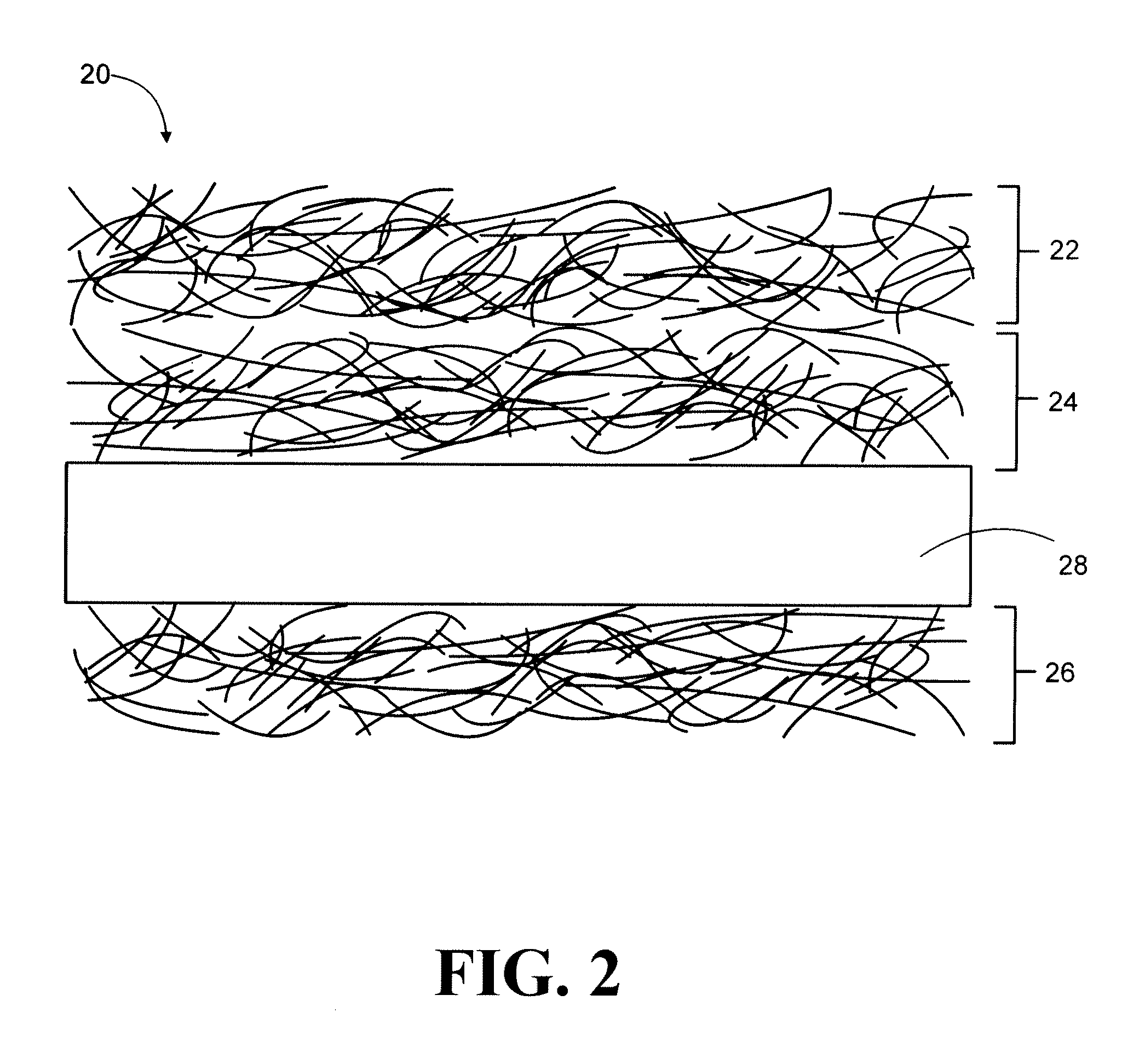Electromagnetic interference shielding structure including carbon nanotube or nanofiber films and methods
a technology of electromagnetic interference and shielding structure, which is applied in the direction of shielding materials, non-metal conductors, conductors, etc., can solve the problems of inability to achieve high nanotube loading and high conductivity in composites, metal adds significant weight and corrosion, and methods are difficult to achieve high cnt loading of cnt composites made by mixing cnts with polymer matrix
- Summary
- Abstract
- Description
- Claims
- Application Information
AI Technical Summary
Benefits of technology
Problems solved by technology
Method used
Image
Examples
example 1
[0101]Inclusion of BP with a thickness of 10-15 μm in a composite with low density polyethylene (LDPE) film (from McMaster, 500 microns in thickness) provided EMI shielding performance, in addition to flexibility and suitable mechanical properties for handling. The polymer film and BP layers were hot pressed at slightly above the melting temperature of the polymer film (149° C.). Test panels (6″×6″) were made. The total thickness of the panels (0.5 mm) was primarily due to the LDPE thickness, since the BP was very thin.
[0102]FIG. 3 shows the scanning electron microscope image of a SWNT / MWNT mixed BP. FIG. 4A shows the SEM image of the fracture surface of a BP composite made by the hot press process and including a polymer film inserted between two BP layers. The BP may be seen on the edge of the panel and LDPE covered the BP layers. FIG. 4B shows the enlarged image of the BP region in the composite. The LDPE polymer around the carbon nanotube was seen and filled some voids in the BP...
example 2
[0106]In this example, a vacuum bagging process was used to make BP composites for EMI shielding tests. Multiple layers of BP with EPON862 resin and polymethacrylimide (PMI) foam were used to compare their multiple reflection contributions to the EMI SE of the resulting composite structures. A modified MIL-STD-285 was adopted for broadband frequency range and a relatively large test panel size (7″×7″) was used. Those results were compared to a theoretical estimation including absorption, reflection, and multiple reflections.
[0107]The nanotube materials used were BuckyPearls™, purified single-walled nanotubes (SWNTs) from Carbon Nanotechnologies Inc (CNI). The SWNT BPs were produced using a filtration process. An aqueous suspension of nanotubes was prepared by a multiple-step dispersion procedure using sonication and a surfactant (Triton X-10, from Fisher Scientific). The suspension was filtered through a 0.45 μm filter in order to produce randomly dispersed BP sheets.
[0108]BPs havin...
example 3
[0122]The EMI SE of BP based composite structures with different conductivities and the effect of multiple layers was studied. A vacuum bagging process was used to make BP composites for EMI shielding tests. The nanotube materials used were BuckyPearls™, purified SWNT (Unidym Inc., TX) made by a Hipco process. In order to reduce the cost and increase the structural integrity of the application, multi-walled carbon nanotubes (MWNTs, Sigma-Aldrich) and vapor-grown carbon nanofiber (VGCNF, Applied Science Inc.) were mixed together with SWNTs in some samples.
[0123]The BPs were produced using the filtration process described in Example 2. SWNT BP having a 15 μm thickness and a basis weight of 21.5 g / m2 were produced because of the BP's high electrical conductivity, extremely lightweight structure, and nanoscale porosity. In the case of SWNT / MWNT mixed BP, MWNT or CNF was mixed with SWNT by weight ratio of 1:3 in the suspension. The typical thickness was 20-25 μm, which was thicker than t...
PUM
 Login to View More
Login to View More Abstract
Description
Claims
Application Information
 Login to View More
Login to View More - R&D
- Intellectual Property
- Life Sciences
- Materials
- Tech Scout
- Unparalleled Data Quality
- Higher Quality Content
- 60% Fewer Hallucinations
Browse by: Latest US Patents, China's latest patents, Technical Efficacy Thesaurus, Application Domain, Technology Topic, Popular Technical Reports.
© 2025 PatSnap. All rights reserved.Legal|Privacy policy|Modern Slavery Act Transparency Statement|Sitemap|About US| Contact US: help@patsnap.com



